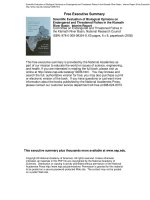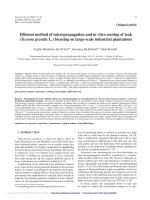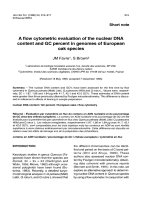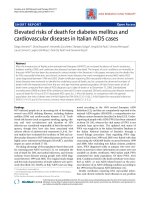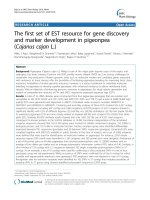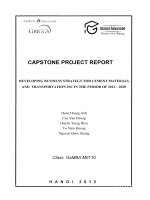Evaluation of provenances for drupe, seed and germination traits in teak (Tectona grandis L. F.) - TRƯỜNG CÁN BỘ QUẢN LÝ GIÁO DỤC THÀNH PHỐ HỒ CHÍ MINH
Bạn đang xem bản rút gọn của tài liệu. Xem và tải ngay bản đầy đủ của tài liệu tại đây (474.63 KB, 7 trang )
<span class='text_page_counter'>(1)</span><div class='page_container' data-page=1>
<i><b>Int.J.Curr.Microbiol.App.Sci </b></i><b>(2017)</b><i><b> 6</b></i><b>(11): 1721-1727 </b>
1721
<b>Original Research Article </b>
<b>Evaluation of Provenances for Drupe, Seed and Germination </b>
<b>Traits in Teak (</b>
<i><b>Tectona grandis</b></i>
<b> L. F.) </b>
<b>Ravindra Kumar Dhaka* and Suman Kumar Jha </b>
Department of Forest Biology and Tree Improvement, College of Forestry, ACHF,
Navsari Agricultural University, Navsari, Gujarat – 396 450, India
<i>*Corresponding author </i>
<i><b> </b></i> <i><b> </b></i><b>A B S T R A C T </b>
<i><b> </b></i>
<b>Introduction </b>
<i>Tectona grandis</i> Linn. f. (family: Lamiaceae)
is the king of timber due to its durability,
physical and aesthetic property. Teak is the
most demanded tropical hardwood for a
specific market of "luxury" applications
including furniture, shipbuilding and
decorative building components (Pandey and
Brown, 2000), which is resistant to termite
and insect attacks (Tewari, 1992). It is a
deciduous diploid tree species with 2n = 36
chromosomes (Hedegart and Eigaard, 1965)
up to 40 m tall. It is native to Southeast Asia
and India; distributed in the states of Kerala,
Tamil Nadu, Karnataka, Andhra Pradesh,
<i>International Journal of Current Microbiology and Applied Sciences </i>
<i><b>ISSN: 2319-7706</b></i><b> Volume 6 Number 11 (2017) pp. 1721-1727 </b>
Journal homepage:
The most valuable timber of the world i.e. teak (king of timber) was widely used due to its
durability, physical and aesthetic property. It has a high demand in international market
and distributed throughout India and Southeast Asia. In addition, there are huge gap
between demand and supply of industrial timber in India. This can be fulfilled by the teak
plantation with agroforestry systems. Therefore, five provenances <i>i.e. Mandvi, Vyara, </i>
Vansda, Chikhali and Dharampur from Gujarat natural teak forests had been selected for
the study to select the better seed source for plantation industry. Our result showed
significant differences (p≤ 0.01) in all the studied characteristics. Drupe were lengthiest
(11.14 mm), broadest (12.64 mm) and heaviest (58.38 g) in Mandvi provenance followed
by Dharampur provenance, whereas smallest (9.69 mm), narrowest (10.48 mm) and
lightest (35.49 g) in Vansda provenance. Similarlly seed length, seed width, 100 seed
weight, filling percent, drupe and seed germination were highest in Mandvi provenance
while lowest in Vansda provenance. Overall, Mandvi and Dharampur provenance were
performed better than all others. It was interesting to see that seed germination was
increased 3-4 folds as compare to drupe germination. This showed that there is a physical
dormancy due to hard or stony hard seed coat in teak fruit for poor drupe germination.
Heritability was revealed that selection can be made for seed germination (h2 = 0.98) as
further genetic improvement of teak while genetic gain coupled with 100 drupe weight
(34.55). Strong inter-character correlation was found among all the traits and drupe as well
as seed traits were influenced on the drupe and seed germination. So, seed germination
among teak provenances was newly added parameter to confirm the presence of physical
dormancy which was a major limiting factor for poor drupe or fruit germination for
deployment of superior genetic materials.
<b>K e y w o r d s </b>
King of timber, Drupe,
Provenance,
Heritability, Genetic
gain, Associations.
<i><b>Accepted: </b></i>
15 September 2017
<i><b>Available Online:</b></i>
10 November 2017
</div>
<span class='text_page_counter'>(2)</span><div class='page_container' data-page=2>
<i><b>Int.J.Curr.Microbiol.App.Sci </b></i><b>(2017)</b><i><b> 6</b></i><b>(11): 1721-1727 </b>
1722
Telengana, Maharashtra, Gujarat,
Chhattisgarh, Madhya Pradesh, Rajasthan,
Uttar Pradesh, Manipur, Orissa <i>etc.</i> (Tewari,
1992). Although the Indian state Gujarat have
natural teak forest in Dangs, Valsad, Navsari,
Tapi, Vadodara, Panchmahal, Dahod,
Sabarkantha and Junagarh districts (GFS,
2012).
There is a huge gap between demand and
supply of industrial timber <i>i.e.</i> 20 million m3
in 1997 and is projected to be touching
around 110 million m3 by 2090 in India
(NRCAF, 2007). This demand can be fulfilled
by teak plantation with agroforestry systems,
but still, there are two major problems <i>i.e. </i>low
seed yield and extremely low germination
rates for the teak plantation industry as well
as researchers (Kaosa-ard, 1981).
Drupe and seed related traits such as fruit
weight, seed size, seed mass and germination
are central components of plant life histories
(Thompson, 1987), which highly influence on
reproduction and seedling establishment
(Grime <i>et al.,</i> 1988).
Thus, seed size, seed dormancy and seed
dispersal has long been conceived significant
impact on reproductive biology of plants and
creating fitness interaction with changing
environment (Venable and Brown, 1988).
Genetic variation among fruit, seed and
germination traits has been documented for
economically useful species such as <i>Tectona </i>
<i>grandis</i> (Jayasankar <i>et al.,</i> 1999; Sivakumar
<i>et al.,</i> 2002), <i>Gmelina arborea</i> (Lauridsen,
2004; Hodge and Dvorak, 2004), <i>Cordia </i>
<i>africana</i> (Loha <i>et al.,</i> 2006; Loha <i>et al.,</i>
2009), <i>Faidherbia albida</i> (lbrahim <i>et al.,</i>
1997), <i>Khaya senegalensis</i> (Ky-Dembele,
2014),<i> Millettia ferruinea</i> (Loha <i>et al.,</i> 2008)
<i>etc.</i> in the tropical environment. Therefore,
the present study has been taken with the
specific objectives: (1) to determine variation
of drupe, seed and germination traits among
teak provenances (2) to select better traits on
the basis of heritability and genetic gain, and
(3) to look inter-character association between
traits.
<b>Materials and Methods </b>
The present research was conducted to
evaluate the five provenances for drupe, seed
and germination traits of teak in Gujarat state.
Fruits/ drupes were collected during April to
July, 2015 from five provenances <i>i.e.</i> Mandvi,
Vyara, Vansda, Chikhali and Dharampur (Fig.
1; Table 1). The Latitude, longitude and
altitude was recorded with the help of GPS
(Table 1).
400 fruits/drupes of 10 trees from each
provenance in four replications (100 fruits/
replications) were measured for analysis of
the drupe and seed attributes. Drupe and seed
traits viz. length (mm), width (mm) and mass
(g) were recorded for all the provenances and
average was computed.
Then drupe was broken by using Falcon
Pruning Secateur to observe number of seed
filling drupe (with one or more seed/kernel in
a drupe). Drupe and seed were sown
separately in the nursery beds with sand: soil:
FYM (2:1:1) and germination was recorded
up to 6 months. All standard nursery practices
followed such watering, weeding <i>etc.</i> time to
time.
</div>
<span class='text_page_counter'>(3)</span><div class='page_container' data-page=3>
<i><b>Int.J.Curr.Microbiol.App.Sci </b></i><b>(2017)</b><i><b> 6</b></i><b>(11): 1721-1727 </b>
1723
<b>Results and Discussion </b>
<b>Phenotypic variation for drupe, seed and </b>
<b>germination attributes among provenances</b>
There were significant differences (p≤ 0.01)
in all the studied traits among five
provenances of <i>T. grandis</i> (Table 2).
Drupe was lengthiest in Mandvi provenance
(11.14±0.23 mm) followed by Dharampur
provenance (10.93±0.28 mm) and smallest in
Vansda provenance (09.02±0.11 mm) of teak
(Table 3). The drupe was broadest in the
Mandvi provenance (12.64±0.38 mm) and
narrowest in Vansda provenance (10.48±0.13
mm). The 100 drupe weight was heaviest in
the Mandvi provenance (58.38±4.59 g)
whereas, the lightest drupe mass was
observed in Vansda provenance (35.49±0.76
g). Highest drupe filling percentage was
recorded in Mandvi provenance (77.00±1.08
%), while lowest in Vansda provenance
(68.75±1.25 %). Similarly, longest, thickest
and heaviest seed of teak was observed in
Mandvi provenance followed by Dharampur
provenance, whereas shortest in Vansda
provenance (Table 3). Drupe and seed
germination percentage was highest in
Mandvi provenance (18.00±1.68, 64.25±1.55
%) whereas lowest in Vansda provenance
(10.25±0.85, 44.75±1.80 %). Overall, Mandvi
and Dharampur provenance were performed
better than all others. It was interesting to see
that seed germination was increased 3-4 folds
as compare to drupe germination (Table 3).
This showed that there is a physical dormancy
due to hard or stony hard seed coat in teak
fruit. This physical dormancy was also
reported by Slator <i>et al.,</i> (2013) for the cause
of poor germination in teak. Jayasankar <i>et al.,</i>
(1999) studied variation in teak drupe
characters of different seed sources in seven
provenances. Variation in different physical
drupe traits such as drupe diameter, drupe
weight, shell weight, mesocarp weight among
30 seed sources from three countries was
observed by Sivakumar <i>et al.,</i> (2002). Sojan
and Indira (2010) also analyzed variability of
seed related characters in teak from western
ghat region among 10 provenances and found
that the mean value of drupe diameter length,
drupe diameter width and 100 drupe weights
were 12.3 mm, 13.6 mm and 53.01g,
respectively. There are several other tropical
tree species where such type seed related
variation found to be useful for tree
improvement such as <i>Gmelina arborea</i>
(Lauridsen, 2004; Hodge and Dvorak, 2004);
<i>Faidherbia albida</i> (lbrahim <i>et al.,</i> 1997);
<i>Millettia ferruinea</i> (<i>Loha et al.,</i> 2008); <i>Cordia </i>
<i>africana</i> (Loha <i>et al.,</i> 2006; Loha <i>et al.,</i>
2009); <i>Khaya senegalensis</i> (Ky-Dembele,
2014). Thus, this variation should be captured
and used for tree improvement programme of
teak in the Gujarat state.
<b>Genetic components, heritability, genetic </b>
<b>advances and genetic gain in teak </b>
</div>
<span class='text_page_counter'>(4)</span><div class='page_container' data-page=4>
<i><b>Int.J.Curr.Microbiol.App.Sci </b></i><b>(2017)</b><i><b> 6</b></i><b>(11): 1721-1727 </b>
1724
<i>al., </i>2008); <i>Cordia africana</i> (Loha <i>et al.,</i> 2006;
Loha <i>et al.,</i> 2009). Thus, drupe mass is the
best trait where selection can be made for
further genetic improvement and better option
for maintaining genetic diversity from
selection.
<b>Table.1 </b>Geo-climatic variables of different provenances of <i>Tectona grandis </i>
<b>Provenance </b> <b>Latitude </b>
<b>(N) </b>
<b>Longitude </b>
<b>(E) </b>
<b>Altitude </b>
<b>(m) </b>
<b>Annual Rainfall </b>
<b>(mm) </b>
<b>Annual Temperature </b>
<b>(°C) </b>
<b>Mandvi </b> 21°14'51.0" 73°18'54.8" 110 1539 27.4
<b>Vyara </b> 20°59'26.4" 73°28'12.2" 120 1705 27.2
<b>Vansda </b> 20°45'41.3" 73°28'32.1" 155 2154 26.9
<b>Chikhali </b> 20°37'56.2" 73°12'38.4" 135 1999 27.1
<b>Dharampur </b> 20°30'52.1" 73°15'58.6" 130 2303 26.8
<b>Table.2 </b>Analysis of variance for drupe, seed and germination traits in <i>T. grandis </i>
<b>Traits </b> <b>Provenance (df = 4) </b>
<b>Mean Square </b> <b>F Value </b> <b>P > F </b>
<b>Drupe Length </b> 3.079 16.515 <0.01
<b>Drupe Width </b> 2.974 9.293 <0.01
<b>100 Drupe Weight </b> 342.369 14.09 <0.01
<b>Drupe Filling </b> 45.175 22.873 <0.01
<b>Seed Length </b> 1.685 16.077 <0.01
<b>Seed Width </b> 0.712 43.142 <0.01
<b>100 Seed Weight </b> 1.465 27.127 <0.01
<b>Drupe Germination </b> 36.425 7.709 <0.01
<b>Seed Germination </b> 244 243.568 <0.01
<b>Table.3 </b>Mean variation for drupe, seed and germination traits among provenances of <i>T. grandis </i>
<b>Provenance </b>
<b>Drupe </b>
<b>Length </b>
<b>(mm) </b>
<b>Drupe </b>
<b>Width </b>
<b>(mm) </b>
<b>100 Drupe </b>
<b>Weight </b>
<b>(g) </b>
<b>Drupe </b>
<b>Filling </b>
<b>(%) </b>
<b>Seed </b>
<b>Length </b>
<b>(mm) </b>
<b>Seed </b>
<b>Width </b>
<b>(mm) </b>
<b>100 Seed </b>
<b>Weight </b>
<b>(g) </b>
<b>Drupe </b>
<b>Germination </b>
<b>(%) </b>
<b>Seed </b>
<b>Germination </b>
<b>(%) </b>
Mandvi 11.14±0.23 12.64±0.38 58.38±4.59 77.00±1.08 6.03±0.25 4.01±0.15 6.00±0.16 18.00±1.68 64.25±1.55
Vyara 09.69±0.20 11.45±0.25 39.87±1.75 70.75±1.11 4.72±0.12 3.27±0.13 4.71±0.11 11.50±0.65 48.25±1.93
Vansda 09.02±0.11 10.48±0.13 35.49±0.76 68.75±1.25 4.50±0.14 2.91±0.15 4.54±0.14 10.25±0.85 44.75±1.80
Chikhali 10.20±0.14 12.13±0.23 47.69±1.97 71.25±1.38 5.03±0.07 3.46±0.14 4.98±0.11 13.25±0.85 54.25±1.80
Dharampur 10.93±0.28 12.33±0.35 52.41±1.82 75.00±1.58 5.70±0.16 3.72±0.16 5.54±0.15 14.75±0.63 58.50±1.44
<b>Mean </b> <b>10.20 </b> <b>11.80 </b> <b>46.77 </b> <b>72.55 </b> <b>5.19 </b> <b>3.47 </b> <b>5.15 </b> <b>13.55 </b> <b>54.00 </b>
SE(m)± 0.22 0.28 2.47 0.70 0.16 0.06 0.12 1.09 0.50
C.D. 0.67 0.88 7.68 2.19 0.50 0.20 0.36 3.39 1.56
</div>
<span class='text_page_counter'>(5)</span><div class='page_container' data-page=5>
<i><b>Int.J.Curr.Microbiol.App.Sci </b></i><b>(2017)</b><i><b> 6</b></i><b>(11): 1721-1727 </b>
1725
<b>Table.4 </b>Variance and genetic component for drupe, seed and germination traits in <i>T. grandis</i>
<b>Traits </b> <b>Phenotypic </b>
<b>Variance </b>
<b>Genotypic </b>
<b>Variance </b> <b>Heritability </b>
<b>Genetic advance </b>
<b>(K=2.06) </b>
<b>Genetic gain </b>
<b>(%) </b>
<b>Drupe Length </b> 0.91 0.72 0.79 1.55 15.20
<b>Drupe Width </b> 0.98 0.66 0.67 1.37 11.61
<b>100 Drupe Weight </b> 103.82 79.52 0.77 16.16 34.55
<b>Drupe Filling </b> 12.78 10.80 0.85 6.26 8.63
<b>Seed Length </b> 0.50 0.40 0.80 1.17 22.54
<b>Seed Width </b> 0.19 0.17 0.89 0.80 23.05
<b>100 Seed Weight </b> 0.41 0.35 0.85 1.12 21.75
<b>Drupe Germination </b> 12.65 7.93 0.63 4.62 34.10
<b>Seed Germination </b> 61.75 60.75 0.98 15.86 29.37
<b>Table.5 </b>Inter-character correlation matrix among drupe, seed and
germination traits of <i>T. grandis </i>
<b>Traits </b> <b>Drupe </b>
<b>Length </b>
<b>Drupe </b>
<b>Width </b>
<b>100 Drupe </b>
<b>Weight </b>
<b>Drupe </b>
<b>Filling </b>
<b>Seed </b>
<b>Length </b>
<b>Seed </b>
<b>Width </b>
<b>100 Seed </b>
<b>Weight </b>
<b>Drupe </b>
<b>Germination </b>
<b>Seed </b>
<b>Germination </b>
<b>Drupe Length </b> 1
<b>Drupe Width </b> 0.96** 1
<b>100 Drupe Weight </b> 0.98** 0.95* 1
<b>Drupe Filling </b> 0.96** 0.88* 0.96** 1
<b>Seed Length </b> 0.97** 0.89* 0.97** 0.99** 1
<b>Seed Width </b> 0.98** 0.96** 0.98** 0.97** 0.97** 1
<b>100 Seed Weight </b> 0.95* 0.87NS 0.97** 0.99** 0.99** 0.96** 1
<b>Drupe Germination </b> 0.94* 0.90* 0.98** 0.97** 0.97** 0.97** 0.98** 1
<b>Seed Germination </b> 0.97** 0.94* 0.99** 0.97** 0.98** 0.98** 0.98** 0.98** 1
Note: * Significant at P < 0.05; ** Significant at P < 0.01; NS is Non-significant
</div>
<span class='text_page_counter'>(6)</span><div class='page_container' data-page=6>
<i><b>Int.J.Curr.Microbiol.App.Sci </b></i><b>(2017)</b><i><b> 6</b></i><b>(11): 1721-1727 </b>
1726
<b>Association between characters </b>
All the drupe, seed and germination traits
showed a strong significant (p <0.01) positive
correlation with each other except drupe
width with 100 seed weight (Table 5). Drupe
length showed a strong correlation with drupe
width (r=0.98) and all others. Then drupe
width exhibited a strong correction with seed
width (r=0.96) and all others except 100 seed
weight. 100 drupe mass showed very strong
association with all the traits. Similarly all
seed and germination traits were closely
associated to each others (Table 5).
Sivakumar <i>et al.,</i> (2002) was studied
inter-character among drupe and seed traits. They
found that drupe diameter, drupe weight, seed
weight, filling percent and germination
parameters were strongly intercorrelated to
each other. Seed width was positively
correlated with seed weight in <i>Millettia </i>
<i>ferruinea</i> (Loha <i>et al.,</i> 2008). Seed length,
width and weight of <i>Cordia africana</i> seed
were showed strongly positive correlation to
each other (Loha <i>et al.,</i> 2009). Thus, all the
drupe, seed and germination traits closely
related to each other and drupe/seed traits
influenced on drupe and seed germination
according to their bigger size.
The most valuable timber of the world known
as king of timber was distributed throughout
India, where Gujarat state has natural teak
forests. Five teak provenances were studied
for drupe, seed and germination traits. All the
characters were showed significant
differences among five provenances of <i>T. </i>
<i>grandis.</i> Overall, Mandvi and Dharampur
provenances were performed better than all
others. Physical dormancy is the major factor
for poor germination in teak for deployment
of superior genetic materials. Heritability was
revealed that selection can be made for seed
germination as further genetic improvement
of teak while genetic gain coupled with 100
drupe weight. Strong inter-character
correlation was found among all the traits and
drupe as well as seed traits were influenced
on the drupe and seed germination.
<b>Acknowledgement </b>
Author (RKD) wish to thank department of
FBTI and acknowledged the Principal and
Dean, College of Forestry, NAU, Navsari,
Gujarat for providing necessary facilities
during the research study.
<b>References </b>
Falconer, D.S., Mackay, T.F. 1996.
Introduction to Quantitative Genetics.
Harlow, UK: Longman Group Ltd., UK.
Grime, J.P., Hodgson, J.G., Hunt, R. 1988.
Comparative Plant Ecology: A
Functional Approach to Common
British Species, London.
Gujarat Forest Statistics. 2012. Gujarat Forest
Statistics 2010-11. Gujarat Forest
Department, Gandhinagar, 105 p.
Hedegart, T., Eigaard, J. 1965. Chromosome
number of Teak (<i>Tectona grandis</i> L. f.).
The Arboretum, Hørsholm, Denmark.
<i>Res. Rep.</i>, 115.
Hodge, G.R., Dvorak, W.S. 2004. The
CAMCORE international provenance/
progeny trials of <i>Gmelina arborea</i>:
genetic parameters and potential gain.
<i>New Forests,</i> 28: 147–166.
Ibrahim, A.M., Fagg, C.W., Harris, S.A.
1997. Seed and seedling variation
amongst provenances in <i>Faidherbia </i>
<i>albida</i>. <i>For. Fcol. Manage.,</i> 97(2):
197-205.
Jayasankar, S., Babu, L.C., Sudhakara, K.,
Dhanesh, K.P. 1999. Evaluation of
provenances for seedling attributes in
teak (<i>Tectona grandis</i> Linn. F.). <i>Silvae </i>
<i>Genetica,</i> 48(3-4): 115-122.
</div>
<span class='text_page_counter'>(7)</span><div class='page_container' data-page=7>
<i><b>Int.J.Curr.Microbiol.App.Sci </b></i><b>(2017)</b><i><b> 6</b></i><b>(11): 1721-1727 </b>
1727
<i>Agron. J.</i>, 47(7):314-318.
Kaosa-ard, A. 1981. Teak (<i>Tectona grandis</i>
Linn. f) its natural distribution and
related factors. <i>Nat. His. Bulletin Siam. </i>
<i>Soc.</i>, 29: 55-74.
Ky-Dembele, C., Tigabu, M., Bayala, J.,
Odén, P.C. 2014. Inter- and intra-
provenances variations in seed size and
seedling characteristics of <i>Khaya </i>
<i>senegalensis</i> A. Juss in Burkina Faso.
<i>Agrofor. Syst.,</i> 88(2): 311-320.
Lauridsen, E.B. 2004. Features of some
provenances in an international
provenance experiment of <i>Gmelina </i>
<i>arborea</i>. <i>New Forests,</i> 28: 127–145.
Loha, A., Tigabu, M., Fries, A. 2009. Genetic
variation among and within populations
of <i>Cordia africana</i> in seed size and
germination responses to constant
temperatures. <i>Euphytica</i>,
165(1):189-196.
Loha, A., Tigabu, M., Teketay, D. 2008.
Variability in seed- and seedling-related
traits of <i>Millettia ferruginea</i>, a potential
agroforestry species. <i>New Forests,</i>
36(1):67-78.
Loha, A., Tigabu, M., Teketay, D., Lundkvist,
K., Fries, A. 2006. Provenance variation
in seed morphometric traits,
germination, and seedling growth of
<i>Cordia africana</i> Lam. <i>New Forests,</i>
32(1):71-86.
National Research Center for Agro Forestry.
2007. NARCAF Perspective
Plan-Vision 2025, National Research Center
for Agroforestry, Jhansi. 46 p.
Pandey, D., Brown, C. 2000. Teak: a global
overview. <i>Unasylva,</i> 201 (51): 22-28.
Panse, V.G., Sukhatme, P.V. 1978. Statistical
Methods for Agricultural Workers.
ICAR, New Delhi. 610p.
Rawat, K., Bakshi, M. 2011. Provenance
variation in cone, seed and seedling
characteristics in natural populations of
<i>Pinus wallichiana</i> AB Jacks (Blue Pine)
in India. <i>Ann. For. Res.</i>, 54(1): 39-55.
Sivakumar, V., Parthiban, K., Singh, B.G.,
Gnanambal, V., Anandalakshmi, R.,
Geetha, S. 2002. Variability in drupe
characters and their relationship on seed
germination in Teak (<i>Tectona grandis</i>
L. f.). <i>Silvae Genetica</i>, 51(5-6):232-236.
Slator, N.J., Callister, A.N., Nichols, J.D.
2013. Mechanical but not physical
dormancy is a cause of poor
germination in teak (<i>Tectona grandis</i>
Lf). <i>New Forests</i>, 44(1): 39-49.
Sojan, J., Indira, E.P. 2010. Variability of
seed related characters in teak (<i>Tectona </i>
<i>grandis</i> L.f.) from Western Ghat region.
<i>Gregor Mendel Fou. J.</i>, 1: 39-44.
Tewari, D.N. 1992. A monograph on teak
(<i>Tectona grandis</i> Linn. f.). International
book distributors, Dehra Dun.
Thompson, K. 1987. Seeds and seed banks.
<i>New Phytologist,</i> 106(s1): 23-34.
Venable, D.L., Brown, J.S. 1988. The
selective interactions of dispersal,
dormancy, and seed size as adaptations
for reducing risk in variable
environments. <i>American </i> <i>Naturalist,</i>
131(3): 360-384.
Zobel, B., Talbert, J. 1984. Applied forest tree
improvement. John Wiley and Sons.
<b>How to cite this article: </b>
</div>
<!--links-->
EVALUATION OF DEMAND FOR INTERDEPENDENT INFRASTRUCTURE INVESTMENTS doc
- 156
- 296
- 0
